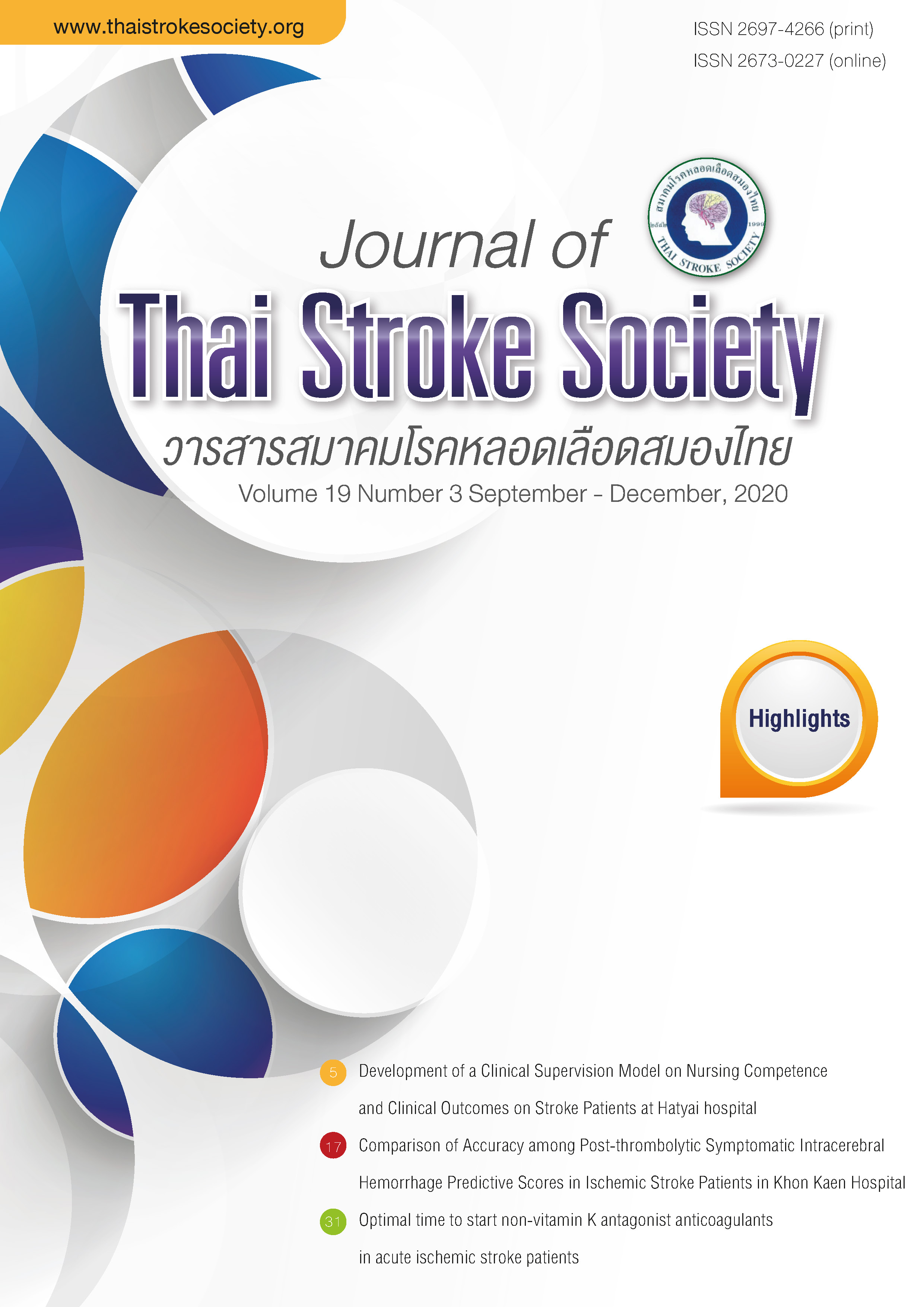Development of a Clinical Supervision Model on Nursing Competence and Clinical Outcomes on Stroke Patients at Hatyai hospital
Keywords:
clinical supervision, nursing competence, clinical outcome, stroke patientsAbstract
Abstract
Objective: To develop and evaluation the effects of a clinical supervision model on nursing competence and stroke outcomes.
Methods: The research and development (R&D) model was implemented during October 2018 to June 2020 at medicine wards of Hatyai Hospital, Songkhla. Three steps approach were generated as following: step 1, identification of nurses mentor’s need and limitations pertaining to clinical supervision in stroke care; step 2, development and implementation of clinical supervision model for nurses mentor; and step 3, evaluation of outcomes. Outcome
Measures: Using pre-post clinical supervision outcomes evaluation. We measured two levels of outcomes including nurses-focused, and patients-focused. Nurses-focused outcomes included nurse mentors supervision competence (n=30) and staff nurses competence on stroke care (n=60), by using performance questionnaires. Patients-focused outcomes were as followed: physical functioning of the stroke patients before discharge (n=1,110) defined by using Barthel Index, and family caregiver competence (n=1,110) performance questionnaire. Paired t-test was performed using SPSS program.
Results: After implemented the clinical supervision program, nurse mentors had higher clinical supervision competence (300 vs. 215, p<0.001), and staff nurses had higher clinical competence (240 vs. 179, p<0.001) compared to previous time before implemented the program. Improved physical functioning was noted by the patients had increased score on Barthel Index (78.75 vs. 74.38, p<0.001), and the greater score on family caregiver competence (87.83 vs. 42.18, p<0.001), respectively.
Conclusion: This study had demonstrated the effectiveness of clinical nurses supervision model on nursing care quality and patient outcomes
References
มาตรฐานโรงพยาบาลและบริการสุขภาพ ฉบับที่ 4.นนทบุรี: หนังสือดีวัน; 2562.
2.Proctor, B. Training for the supervision alliance attitude, skills and intention, in J.R.
Cutcliffe,T. Butterworth and B. Proctor (ends), Fundamental Themes in Clinical
Supervision, London: Routledge 2001; 25–46.
3.เพ็ญจันทร์ แสนประสาน. มาตรฐานการบริหาร องค์กรการพยาบาลและการผดุงครรภ์.
[อินเตอร์เน็ต] [สืบค้นเมื่อ 20 มิ.ย. 2561]. แหล่งข้อมูล
http://www.thaiheart.org/images/column
4.Alexander, G. Behavioral coaching-the GROW model In Passmore, Jonathan.
Excellence in coaching: The industry guide. (2nded.). Philadelphia: Kogan;2010.
5.ผ่องศรี สุวรรณพายัพ, พรทิพย์ สุขอดิศัย และกรรณิกา อำพน.การพัฒนารูปแบบการนิเทศ
ทางการพยาบาล กลุ่มการพยาบาลโรงพยาบาลพระปกเกล้า.วารสารการพยาบาลและ การศึกษา 2556; 6(1):12-26.
6.งานเวชระเบียนและสถิติ ข้อมูลหน่วยเวชระเบียนและสถิติโรงพยาบาลหาดใหญ่ จำนวน
ผู้ป่วยโรคหลอดเลือดสมอง โรงพยาบาลหาดใหญ่ จังหวัดสงขลา; 2562.
7.บุญใจ ศรีสถิตย์นารกูร. ระเบียบวิธีวิจัยทางการพยาบาลศาสตร์(พิมพ์ครั้งที่ 5) กรุงเทพฯยู แอนไอ อินเตอร์มีเดีย; 2553.
8.นิตยา ศรีญาณลักษณ์. การบริหารการพยาบาล. นนทบุรี: ธนาเพลสจำกัด; 2552.
9.นัยนา ทองทวน. การพัฒนารูปแบบการส่งเสริมการใช้กระบวนการพยาบาลในการปฏิบัติการ
พยาบาล งานผู้ป่วย ในกลุ่มการพยาบาล โรงพยาบาล 50 พรรษา มหาวชิราลงกรณ์ จังหวัดอุบลราชธานี. [วิทยานิพนธ์]. ขอนแก่น: มหาวิทยาลัยขอนแก่น; 2557.
10.กนกรัตน์ แสงอำไพ. ผลของการนิเทศทางคลินิกต่อความ รู้ ความสามารถในการปฏิบัติการ
พยาบาลเพื่อจัดการความ ปวดในผู้ป่วยหลังผ่าตัด และความพึงพอใจในการนิเทศ ของพยาบาล.วารสารกองการพยาบาล 2552; 36 (1): 1-14.
11.เผอิญ ณ พัทลุง.บทบาทการนิเทศของหัวหน้าหอผู้ป่วยที่เป็นจริงและที่คาดหวังด้านการใช้
กระบวนการพยาบาล ด้านการบันทึกทางการพยาบาลและด้านการพัฒนาความรู้ของบุคลากร ในโรงพยาบาลสงขลา. วารสารเครือข่ายวิทยาลัยพยาบาลและการสาธารณสุข ภาคใต้ 2559; 3(1): 192-206.
Downloads
Published
How to Cite
Issue
Section
License
ข้อความภายในบทความที่ตีพิมพ์ในวารสารสมาคมโรคหลอดเลือดสมองไทยเล่มนี้ ตลอดจนความรับผิดชอบด้านเนื้อหาและการตรวจร่างบทความเป็นของผู้นิพนธ์ ไม่เกี่ยวข้องกับกองบรรณาธิการแต่อย่างใด การนำเนื้อหา ข้อความหรือข้อคิดเห็นของบทความไปเผยแพร่ ต้องได้รับอนุญาตจากกองบรรณาธิการอย่างเป็นลายลักษณ์อักษร ผลงานที่ได้รับการตีพิมพ์ในวารสารเล่มนี้ถือเป็นลิขสิทธิ์ของวารสาร





